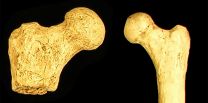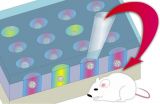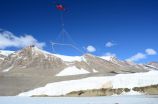Not much size difference between male and female Australopithecines
2015-04-28
Lucy and other members of the early hominid species Australopithecus afarensis probably were similar to humans in the size difference between males and females, according to researchers from Penn State and Kent State University.
"Previous convention in the field was that there were high levels of dimorphism in the Australopithecus afarensis population," said Philip Reno, assistant professor of anthropology, Penn State. "Males were thought to be much larger than females."
Sexual dimorphism refers to differences between males and females of a species. These can show up, ...
New study links drinking behaviors with mortality
2015-04-28
A new University of Colorado Boulder study involving some 40,000 people indicates that social and psychological problems caused by drinking generally trump physically hazardous drinking behaviors when it comes to overall mortality rates.
The study showed, for instance, that participants who had experienced an intervention by physicians, family members or friends had a 67 percent greater risk of death over the 18-year study period, said sociology Professor Richard Rogers, lead study author. Those who reported cutting down on social or sports activities because of alcohol ...
Study allays concerns that cardiothoracic physicians-in-training provide suboptimal care
2015-04-28
When educating medical students or residents to perform highly technical procedures, there is always a challenge to balance the educational mission with maintaining quality results and optimal patient care. This report compared outcomes of cardiac surgery residents to those of attending physicians in performing coronary artery bypass grafting. It found no differences in patient outcomes or graft patency between the residents and attending surgeons.
Seattle WA, April 28, 2015 - A conundrum in medical education is how to train residents in complex and technically difficult ...
Age at surgery and valve type in PVR key determinants of re-intervention in congenital heart disease
2015-04-28
Over the last 15 years, survival of children with congenital heart disease (CHD) has greatly improved, so that currently there are more adults than children living with CHD. Consequently, people with CHD of all ages are undergoing pulmonary valve replacement (PVR) with bioprosthetic valves. In this retrospective review of all patients with CHD who underwent bioprosthetic PVR over an 18-year period at Boston Children's Hospital, investigators found that young age and small body weight predisposed patients toward re-intervention, as did the type of valve used.
Seattle, ...
Boston Children's Hospital study reveals first 6 months best for stimulating heart growth
2015-04-28
Boston, Mass (April 27, 2015) -- In a recent issue of Science Translational Medicine, Brian Polizzotti, PhD, Bernhard Kuhn, MD, Sangita Choudhury, PhD, and colleagues affiliated with the Boston Children's Hospital's Translational Research Center report that the optimal window of time to stimulate heart muscle cell regeneration (cardiomyocyte proliferation) in humans is the first six months of life.
"Our results suggest that early administration of neuregulin may provide a targeted and multipronged approach to prevent heart failure in infants with CHD. Beginning treatment ...
Genetic markers for fetal overgrowth syndrome discovered
2015-04-28
Humans and cattle share a similar epigenetic fetal overgrowth disorder that occurs more commonly following assisted reproduction procedures. In humans, this disorder is called Beckwith-Wiedemann syndrome (BWS), and in cattle it is called large offspring syndrome (LOS) and can result in the overgrowth of fetuses and enlarged babies. This naturally occurring, but rare syndrome can cause physical abnormalities in humans and cattle and often results in the deaths of newborn calves and birth-related injuries to their mothers.
Now, researchers at the University of Missouri ...
Study shows diversity of habitat needed around spotted owl reserves
2015-04-28
CHESTER, Calif. - A study just published this week shows many bird species, including several of high conservation concern, aren't getting the habitat they need due to a focus on promoting California Spotted Owl habitat in the northern Sierra Nevada.
The study, published in the science journal, PLoS ONE, tracked different bird species' use of areas inside and outside Spotted Owl reserves for two years in Plumas and Lassen National Forests. The results show 17 species avoided the reserves, including species of conservation concern like Yellow Warblers and Olive-sided ...
Emergency department treatment for opioid addiction better than referrals
2015-04-28
New Haven, Conn. -- Yale researchers conducted the first known randomized trial comparing three treatment strategies for opioid-dependent patients receiving emergency care. They found that patients given the medication buprenorphine were more likely to engage in addiction treatment and reduce their illicit opioid use.
Dependence on prescription and illicit opioids is an epidemic that continues to grow in the United States and globally. Drug overdoses account for more deaths each day than car crashes. "This is a huge public health problem," said first author Dr. Gail D'Onofrio, ...
Windows that act like an LCD Screen
2015-04-28
WASHINGTON, DC, April 28, 2015 -- The secret desire of urban daydreamers staring out their office windows at the sad brick walls of the building opposite them may soon be answered thanks to transparent light shutters developed by a group of researchers at Pusan National University in South Korea.
A novel liquid crystal technology allows displays to flip between transparent and opaque states -- hypothetically letting you switch your view in less than a millisecond from urban decay to the Chesapeake Bay. Their work appears this week in the journal AIP Advances, from AIP ...
New IVF device may improve fertility treatment
2015-04-28
WASHINGTON, D.C., April 28, 2015--For couples struggling to conceive the old-fashioned way, in vitro fertilization (IVF) provides an alternate route to starting a family. When eggs are mixed with sperm in test tubes, the fertilized eggs to grow into embryos that can be implanted inside the uterus of a woman who will carry them to term.
IVF often works miracles for infertile couples, a fact for which its inventor won a Nobel Prize a few years ago. However, the procedure can be time-consuming, costly, and emotionally draining, often requiring multiple implantation cycles ...
Tracking exploding lithium-ion batteries in real-time
2015-04-28
What happens when lithium-ion batteries overheat and explode has been tracked inside and out for the first time by a UCL-led team using sophisticated 3D imaging.
Understanding how Li-ion batteries fail and potentially cause a dangerous chain reaction of events is important for improving their design to make them safer to use and transport, say the scientists behind the study.
Hundreds of millions of these rechargeable batteries are manufactured and transported each year as they are integral to modern living, powering mobile phones, laptops, cars and planes. Although ...
Scientists discover salty aquifer, previously unknown microbial habitat under Antarctica
2015-04-28
HANOVER, N.H. - Using an airborne imaging system for the first time in Antarctica, scientists have discovered a vast network of unfrozen salty groundwater that may support previously unknown microbial life deep under the coldest, driest desert on our planet. The findings shed new light on ancient climate change on Earth and provide strong evidence that a similar briny aquifer could support microscopic life on Mars.
The study appears in the journal Nature Communications. It is available through open access. A PDF of the study, photos and video also are available on request. ...
Two-week international diet swap shows potential effects of food on colon cancer risk
2015-04-28
PITTSBURGH, April 28, 2015 - African-Americans and Africans who swapped their typical diets for just two weeks similarly exchanged their respective risks of colon cancer as reflected by alterations of their gut bacteria, according to an international study led by researchers at the University of Pittsburgh School of Medicine published online today in Nature Communications.
Principal investigator Stephen O'Keefe, M.D., professor of medicine, Division of Gastroenterology, Hepatology and Nutrition, Pitt School of Medicine, observed while practicing in South Africa that his ...
UT research uncovers lakes, signs of life under Antarctica's dry valleys
2015-04-28
KNOXVILLE--Many view Antarctica as a frozen wasteland. Turns out there are hidden interconnected lakes underneath its dry valleys that could sustain life and shed light on ancient climate change.
Jill Mikucki, a University of Tennessee, Knoxville, microbiology assistant professor, was part of a team that detected extensive salty groundwater networks in Antarctica using a novel airborne electromagnetic mapping sensor system called SkyTEM.
The research, funded by the National Science Foundation, provides compelling evidence that the underground lakes and brine-saturated ...
Studies in cell transplantation show beneficial effects for variety of serious conditions
2015-04-28
Putnam Valley, NY. (April 28, 2015) - Five studies from the current special issue of Cell Transplantation 24(4) devoted to work presented at the 21st meeting of the American Society for Neural Therapy and Repair (ASNTR) in 2014, a society for scientists focused on understanding the causes of, and developing cell and gene therapy and biopharmaceuticals for neurological injury and disease, are currently freely available on-line at: http://www.ingentaconnect.com/content/cog/ct/2015/00000024/00000004.
MSCs promote improvement in patient with complete spinal cord injury
Complete ...
Small high school reform boosts districtwide outcomes
2015-04-28
Creating small high schools improves outcomes for students in the overall school district - both in new small schools and existing larger schools - according to a study of New York City schools by researchers at New York University, Syracuse University, and Arizona State University.
The findings, published in the April issue of Educational Researcher, help to answer questions of whether introducing small high schools comes at an expense to the rest of the school district.
"Our findings suggest that there was real, meaningful improvement in New York City's high school ...
Northwestern medicine researchers solve mystery of deadly transplant infection
2015-04-28
CHICAGO, ILL. - When Harlan Dorbin passed away from a rare infection one month after his successful lung transplant surgery, his surgeon turned to Dorbin's sister and made a promise.
"I told her I would get to the bottom of this," said Ankit Bharat, MD, a thoracic surgeon and surgical director of the Northwestern Medicine® lung transplant program. "It was a perfect operation yet this infection caused an abnormal buildup of ammonia that a person's body can't sustain. It's rare but it's almost always fatal. No one knew the cause or how to prevent it. This simply wasn't ...
Study: A minority of women seek health care after military sexual assault
2015-04-28
Despite growing public awareness of sexual assault of women during their military service and increased efforts by the Department of Defense to deter sexual crimes and encourage reporting and help-seeking, a Veterans Affairs study suggests most female service members who experience sexual assault are still unlikely to seek post-assault health care, at least in the short term.
The study, published in Medical Care in April 2015, found that fewer than a third of sexually assaulted servicewomen sought such care.
The low numbers are notable, say researchers, because women ...
Water could have been abundant in the first billion years
2015-04-28
How soon after the Big Bang could water have existed? Not right away, because water molecules contain oxygen and oxygen had to be formed in the first stars. Then that oxygen had to disperse and unite with hydrogen in significant amounts. New theoretical work finds that despite these complications, water vapor could have been just as abundant in pockets of space a billion years after the Big Bang as it is today.
"We looked at the chemistry within young molecular clouds containing a thousand times less oxygen than our Sun. To our surprise, we found we can get as much water ...
Scientists find new mutation that may lead to better diabetes medications and prevention
2015-04-28
LOS ANGELES (April 28, 2015) - An international team of scientists led by a Cedars-Sinai researcher has identified a new genetic mutation that appears to protect people from developing Type 2 diabetes.
The finding could lead to the development of new drug therapies to treat about 26 million Type 2 diabetics in the United States who rely on insulin and oral medication to manage the life-threatening disease for which there is no cure.
"We have a wonderful opportunity to personalize the treatment and prevention of this chronic disease," said Mark O. Goodarzi, MD, PhD, ...
Partially logged rainforests could be emitting more carbon than previously thought
2015-04-28
Global carbon emissions from forests could have been underestimated because calculations have not fully accounted for the dead wood from logging.
Living trees take in carbon dioxide whereas dead and decaying ones release it. Understanding the proportion of both is important for determining whether a large area of forest is a source of carbon dioxide, or a 'sink' that helps to absorb carbon dioxide from the atmosphere.
Forestry, agriculture and land-use changes account for nearly 25 per cent of global greenhouse gas emissions, second only to the energy sector. New research ...
The chemistry of The Avengers (video)
2015-04-28
WASHINGTON, April 28, 2015 -- Science fans, assemble! On May 1, the world's top superhero team is back to save the day in "Avengers: Age of Ultron." This week, Reactions looks at the chemistry behind these iconic heroes' gear and superpowers, including Tony Stark's suit, Captain America's shield and more. Check out the video here: https://youtu.be/Gr3ov7R89Xo.
Subscribe to the series at http://bit.ly/ACSReactions, and follow us on Twitter @ACSreactions to be the first to see our latest videos.
INFORMATION:
The American Chemical Society is a nonprofit organization ...
Living liver donors report lower sexual function in early months post-surgery
2015-04-28
A new study found that sexual function in adult living donors was lower at the evaluation phase and at three months following liver transplantation. Results published in Liver Transplantation, a journal of the American Association for the Study of Liver Diseases and the International Liver Transplantation Society, suggest that donor education prior to surgery may improve recovery and ease concerns about sexual function following the transplant.
Living liver donors provide a healthy portion of their liver to an individual with end-stage liver disease. These donors make ...
Keeping food visible throughout the house is linked to obesity
2015-04-28
COLUMBUS, Ohio - Researchers have identified two seemingly unrelated but strong predictors of obesity: having low self-esteem related to one's weight and keeping food visibly available around the house, outside the kitchen.
The Ohio State University study focused primarily on determining whether the home environment - architectural features and food storage and availability - was associated with obesity, but also measured a number of psychological factors. While architectural features had no relationship to obesity status, several food-related findings did.
People in ...
Cell-assisted lipotransfer: Safety not demonstrated
2015-04-28
In reconstructive and esthetic medicine, a technique called cell-assisted lipotransfer, i.e., the grafting of the patient's own adipose tissue to another site in the body after mixing with autologous stem cells, is being increasingly used and aggressively promoted. This technique has not been shown to yield better outcomes than conventional lipotransfer without cell enrichment, as discussed by Soraya Grabin and coauthors in a current article in Deutsches Ärzteblatt International (Dtsch Arztebl Int 2015; 112: 255-61). The vitally important matter of safety--in particular, ...
[1] ... [2888]
[2889]
[2890]
[2891]
[2892]
[2893]
[2894]
[2895]
2896
[2897]
[2898]
[2899]
[2900]
[2901]
[2902]
[2903]
[2904]
... [8705]
Press-News.org - Free Press Release Distribution service.









